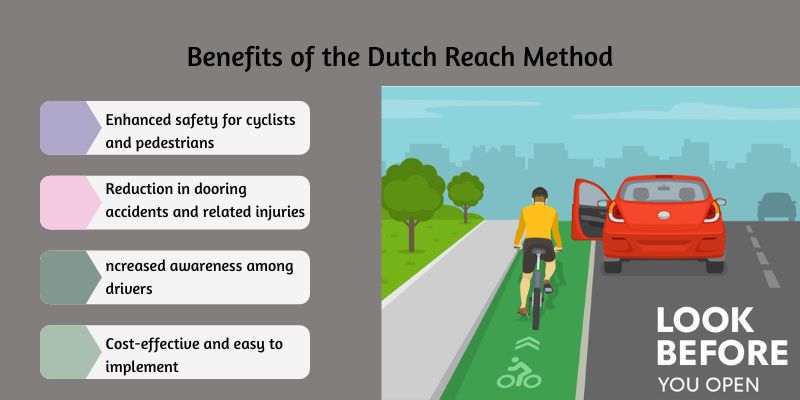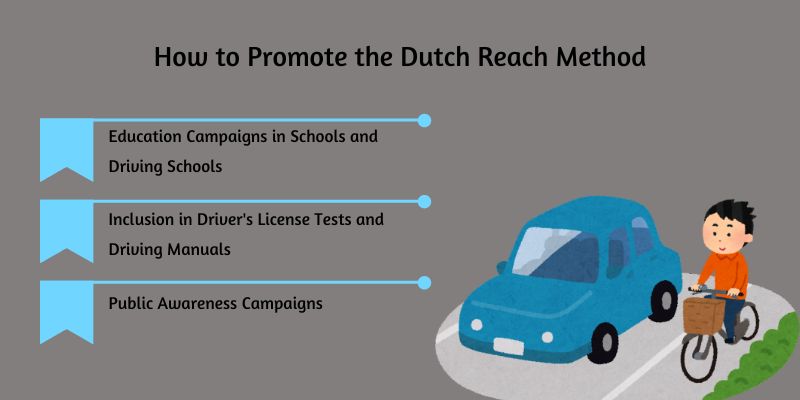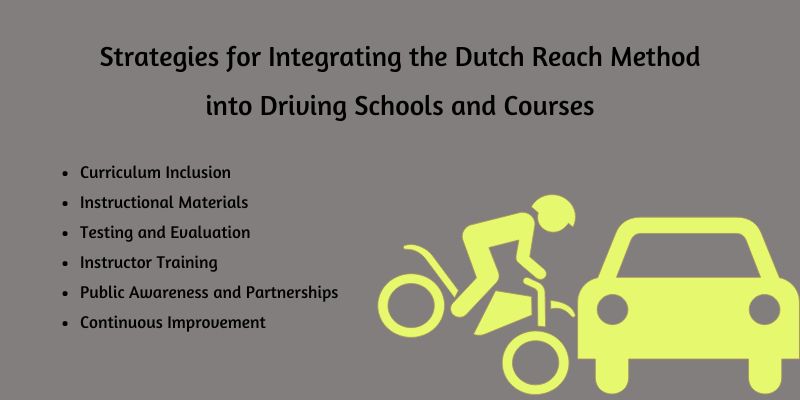The Dutch Reach method is a simple but effective technique designed to prevent dooring accidents, where a vehicle's door is opened into the path of a passing cyclist or another vehicle.
Originating in the Netherlands, this method involves using your far hand to open the car door instead of the hand closest to it.
This seemingly minor adjustment helps drivers naturally turn their heads and look behind them, improving their awareness of the road and potential hazards.
Dooring accidents are a significant concern for cyclists and drivers alike.
According to Montreal Public Health, 309 people were victims of ‘dooring’ between 2019 and 2022.
These statistics reveal that these incidents can cause serious injuries or even fatalities.
Unfortunately, the rise in cycling popularity in Canada has been accompanied by increased such accidents. The Dutch Reach method addresses this issue by encouraging safer door-opening practices.
We can substantially impact road safety by incorporating the Dutch Reach into everyday driving routines.
This blog will explore the workings of the Dutch Reach method, its benefits, and practical tips for adopting it.
History and Origin
The Dutch Reach method has its roots in the Netherlands, a country known for its extensive cycling culture and infrastructure.
The practice emerged as a practical solution to the problem of dooring accidents, which occur when a car door is opened into the path of a cyclist.
In the Netherlands, cycling is a primary mode of transportation, with over 22 million bicycles in a country of 17 million people. Given this context, the Dutch Reach method became a natural and necessary part of driver education.
Adoption and Promotion in Various Countries
The effectiveness of the Dutch Reach method quickly got international attention. As cycling gained popularity worldwide, so did the need for safer interactions between motorists and cyclists.
Countries with solid cycling cultures, like Denmark and Germany, began promoting the Dutch Reach through public safety campaigns and driver education programs.
In recent years, the method has been increasingly adopted in North America, including Canada and the United States.
Advocacy groups, cycling organizations, and traffic safety authorities have actively promoted the Dutch Reach as part of broader initiatives to improve road safety.
It has even been incorporated into official driving manuals and tests in some regions, reflecting its importance in fostering safer road-sharing practices.
The growing adoption of the Dutch Reach method underscores its value as a simple yet effective tool for preventing dooring accidents.
Learning from the Dutch and integrating this practice into our daily routines can create a safer and more cyclist-friendly environment.
What is the Dutch Reach Method?
The Dutch Reach method is a simple yet highly effective technique designed to prevent dooring accidents, which occur when a driver or passenger opens a car door into the path of an oncoming cyclist.
The essence of the Dutch Reach method is in the way the car door is opened: instead of using the hand closest to the door, the person uses the far hand.
For example, a driver in a left-hand drive vehicle would use their right hand to open the door.
This action naturally forces the body to turn, prompting the person to look over their shoulder and check for any approaching cyclists or vehicles before opening the door.
How It Works
- Reach Across: Instead of using the hand nearest to the door handle (usually the left hand for the driver), use the opposite hand (the right hand).
- Turn and Look: As you reach across your body, this movement encourages your torso to turn. This turning motion naturally makes you look over your shoulder.
- Check for Cyclists: Before you fully open the door, turn and look over your shoulder to check for oncoming cyclists or vehicles in the blind spot.
- Open the Door: Once you have confirmed it is safe, you can open it slowly and exit the vehicle.
Why It's Effective
The Dutch Reach method significantly reduces the risk of dooring incidents because it integrates an additional safety check into the routine of exiting a vehicle.
By using the far hand to open the door, drivers and passengers will likely spot an approaching cyclist or vehicle that might otherwise go unnoticed.
This simple change in habit can prevent potentially serious or even fatal accidents, making it a critical practice in areas with high bicycle traffic.
Benefits of the Dutch Reach Method

The Dutch Reach method offers numerous benefits, making it a highly effective and practical approach to enhancing road safety.
This simple technique improves the safety of cyclists and pedestrians and promotes greater awareness among drivers and passengers, reducing the incidence of dooring accidents.
The method's ease of implementation and cost-effectiveness further underscore its value as a safety measure that can be adopted widely with minimal effort.
Enhanced Safety for Cyclists and Pedestrians
One of the primary benefits of the Dutch Reach method is the significant enhancement of safety for cyclists and pedestrians.
This technique prompts drivers and passengers to turn and look over their shoulders before opening the door, which increases their likelihood of noticing approaching cyclists and pedestrians.
This awareness helps prevent accidents caused by suddenly opening a car door into the path of a cyclist or pedestrian, thereby reducing the risk of serious injuries or fatalities.
Reduction in Dooring Accidents and Related Injuries
Dooring accidents, where cyclists collide with an abruptly opened car door, are a common and often severe type of traffic incident.
The Dutch Reach method directly addresses this issue by incorporating a visual check for cyclists and other road users when exiting a vehicle. This practice can lead to a substantial reduction in dooring accidents and the injuries associated with them.
Statistics from countries that have promoted this method show a noticeable decline in such incidents, highlighting the effectiveness of the Dutch Reach in improving road safety.
Increased Awareness Among Drivers
Implementing the Dutch Reach method also promotes awareness among drivers and passengers.
Reaching across the body to open the door naturally encourages individuals to be more mindful of their surroundings.
This heightened awareness extends beyond just preventing dooring accidents; it cultivates a habit of checking for cyclists, pedestrians, and other vehicles more generally.
This broader awareness contributes to safer driving practices and a more vigilant approach to road safety.
Cost-Effective and Easy to Implement
One of the standout advantages of the Dutch Reach method is its cost-effectiveness and ease of implementation.
Unlike other safety measures that may require significant investment in infrastructure or technology, the Dutch Reach requires no financial outlay. This behavioral change can be taught and adopted quickly and easily.
Educational campaigns, such as posters, videos, and community outreach programs, can effectively promote this method without substantial costs.
Additionally, because it is a simple habit change, it can be universally applied by drivers and passengers of all ages and abilities.
The Dutch Reach method offers a practical, cost-effective, and highly impactful way to enhance road safety.
This method represents a valuable addition to road safety practices by improving safety for cyclists and pedestrians, reducing dooring accidents, increasing driver awareness, and being accessible to adopt.
Encouraging the widespread use of the Dutch Reach can lead to safer streets and a more mindful driving culture, ultimately benefiting all road users.
How to Promote the Dutch Reach Method

Promoting the Dutch Reach method involves integrating education, policy changes, and public awareness efforts.
Utilizing this simple yet effective safety technique in various aspects of driver education and public outreach can significantly enhance its adoption and improve road safety for everyone.
Education Campaigns in Schools and Driving Schools
Integrating the Dutch Reach method into schools' curriculum and driving schools is a foundational step in promoting this safety practice.
Educating young students and new drivers about the Dutch Reach early in their learning journey can instill this habit from the outset.
In schools, lessons on road safety can include demonstrations of the Dutch Reach method, emphasizing its importance for preventing dooring accidents.
Teachers can use interactive activities like role-playing exercises to help students understand and practice the technique.
In driving schools, instructors can incorporate the Dutch Reach method into practical driving lessons and theory classes. By demonstrating the method during behind-the-wheel training, new drivers can see firsthand how simple and effective it is.
Driving schools can also include the Dutch Reach in their instructional materials and handbooks, ensuring it becomes a standard part of driver education.
Inclusion in Driver's License Tests and Driving Manuals
Another critical strategy for promoting the Dutch Reach method is to include it in driver's license tests and official driving manuals. This formalizes the practice and underscores its importance as a standard driving safety measure.
Driver's license tests can incorporate questions about the Dutch Reach method in both the written and practical components.
For example, examiners can evaluate a new driver's ability to safely exit a vehicle using the Dutch Reach during the road test. Including this requirement in the testing process ensures that all new drivers are aware of and competent in this safety technique.
By including it in these official publications, transportation authorities signal that this practice is essential to safe driving. This inclusion also provides a consistent message across all learning materials, reinforcing the habit among drivers.
Public Awareness Campaigns
Public awareness campaigns are vital in promoting the Dutch Reach method to a broader audience.
These campaigns can leverage various media channels to reach drivers of all ages and backgrounds, making the method a widely recognized and adopted practice.
Posters and flyers can be strategically placed in parking lots, gas stations, and public transportation hubs.
These materials can feature clear instructions and compelling visuals to demonstrate the Dutch Reach method, making it easy for people to understand and remember.
Social media platforms offer a powerful tool for spreading awareness quickly and engagingly. Short videos, infographics, and posts highlighting the benefits of the Dutch Reach method can reach a broad audience.
Encouraging users to share these materials can amplify the message and promote a community of safety-conscious drivers.
Public service announcements (PSAs) on radio, television, and online streaming services can further promote the Dutch Reach method.
These announcements can feature testimonies from cyclists, safety experts, and drivers who have adopted the method, adding credibility and relatability to the campaign.
PSAs can also highlight statistics on dooring accidents, reinforcing the importance of adopting this practice.
Promoting the Dutch Reach method requires a multifaceted approach that combines education, policy integration, and widespread public awareness efforts.
By embedding this safety technique into school curriculums, driving tests, manuals, and public campaigns, we can build a culture of mindfulness and responsibility among drivers.
This comprehensive strategy will help ensure the Dutch Reach method becomes a standard practice, leading to safer roads for all.
The Role of Training for Driver Safety
Training plays an essential role in ensuring driver safety. Comprehensive driver education equips new drivers with the skills needed to operate a vehicle and instills lifelong habits that contributing to road safety.
An online defensive driving course by the Canada Safety Training Centre can help participants understand the benefits, share examples, and implement techniques to help them be mindful of road safety.
This course can also explain common safety tips that help with a smooth drive at night, on highways, and in adverse weather conditions.
Importance of Incorporating the Dutch Reach into Driver Education
Incorporating the Dutch Reach into driver education is crucial for several reasons:
- Prevention of Dooring Accidents: Dooring accidents occur when a car door is opened into the path of an oncoming cyclist or pedestrian. These incidents can cause severe injuries and even fatalities. The Dutch Reach method, which involves using the far hand to open the car door, naturally prompts the driver to turn their body and look over their shoulder, increasing their awareness of oncoming traffic. We can significantly reduce dooring accidents by making this a standard part of driver education.
- Cultivation of Safe Habits: Habits formed during driver training often last a lifetime. By teaching new drivers the Dutch Reach method, we can help them develop a habit that will contribute to safer road practices throughout their driving careers. This method is easy to learn and can be seamlessly integrated into existing driver training programs.
- Enhanced Cyclist and Pedestrian Safety: Cyclists and pedestrians are vulnerable road users who are often at greater risk in traffic environments. Educating drivers about the Dutch Reach method protects these vulnerable groups and promotes a culture of shared road responsibility. This awareness can lead to more considerate and attentive driving behavior.
- Compliance with Safety Standards: As awareness of the Dutch Reach method grows, it is increasingly being recognized and promoted by traffic safety organizations and regulatory bodies. Incorporating this method into driver education ensures that new drivers are up-to-date with best practices and safety standards, making them more responsible and informed road users.
Strategies for Integrating the Dutch Reach Method into Driving Schools and Courses

Integrating the Dutch Reach method into driving schools and courses requires a strategic approach. Here are some strategies to achieve this:
Curriculum Inclusion
Driving schools should include the Dutch Reach method in their curriculum's theoretical and practical components. This can be achieved by:
- Theoretical Lessons: Include the Dutch Reach method in classroom sessions where students learn about road safety, driving techniques, and defensive driving. Use visual aids, such as videos and diagrams, to demonstrate the method's benefits.
- Practical Training: During behind-the-wheel training, instructors can demonstrate the Dutch Reach method and supervise students as they practice it. By incorporating this practice into real-world driving scenarios, students can develop muscle memory and make it a natural part of their routine.
Instructional Materials
Update instructional materials such as textbooks, handbooks, and online resources to include information about the Dutch Reach method.
These materials should provide clear, step-by-step instructions on performing the method and explain its importance and benefits.
Testing and Evaluation
Integrate the Dutch Reach method into driving tests. This can include:
- Written Tests: Include questions about the Dutch Reach method in the theoretical exam to ensure students understand its purpose and how to execute it.
- Practical Tests: Evaluate students' ability to perform the Dutch Reach during the road test. This ensures that they can apply the technique correctly in real-world situations.
Instructor Training
Provide driving instructors with training on the Dutch Reach method.
Instructors should know the technique and its benefits so that they can teach it to their students effectively.
This training can be part of regular professional development programs for driving instructors.
Public Awareness and Partnerships
Collaborate with local traffic safety organizations, cycling groups, and government agencies to promote the Dutch Reach method.
Public awareness campaigns can complement the efforts of driving schools by reaching a wider audience.
Partnerships with these organizations can also provide additional resources and support for integrating the method into driver education.
Continuous Improvement
Review and update driver education programs regularly to reflect the latest best practices and safety standards.
Solicit feedback from students and instructors to identify areas for improvement and make necessary adjustments to the curriculum.
By adopting these strategies, driving schools can effectively integrate the Dutch Reach method into their training programs, promoting safer driving habits and reducing the risk of dooring accidents.
This comprehensive approach to driver education will ultimately contribute to safer roads and a more aware and considerate driving culture.
Dutch Reach Method - FAQs
How does the Dutch Reach method work?
The Dutch Reach method uses your far hand to open the car door, prompting you to turn and check for oncoming cyclists or pedestrians.
Is the Dutch Reach method challenging to learn?
The Dutch Reach method is simple to learn and quickly becomes a natural habit with practice.
What should I do to remember to use the Dutch Reach?
If you forget to use the Dutch Reach, take a moment to check your mirrors and look over your shoulder before opening the door to ensure it's safe.
Final Words
The Dutch Reach method is simple yet highly effective in preventing dooring accidents and enhancing road safety for cyclists and pedestrians.
Originating in the Netherlands, this method has gained recognition and adoption in various countries due to its significant benefits.
By using the far hand to open car doors, drivers are naturally prompted to turn and check their surroundings, reducing the risk of collisions with oncoming cyclists and pedestrians.
The Dutch Reach method enhances safety and improves driver awareness. It is cost-effective, easy to implement, and easily incorporated into daily routines.
Promoting this method through education campaigns in schools, driving schools, and public awareness initiatives is crucial. Including it in driver's license tests and driving manuals will ensure widespread adoption.
Incorporating the Dutch Reach into driver education programs is essential for creating a safer environment for everyone on the road. With a collective effort, we can reduce dooring incidents and related injuries, making our streets safer for all.
By practicing and promoting the Dutch Reach method, we contribute to a culture of safety, vigilance, and consideration, ultimately protecting the lives of cyclists, pedestrians, and drivers alike.